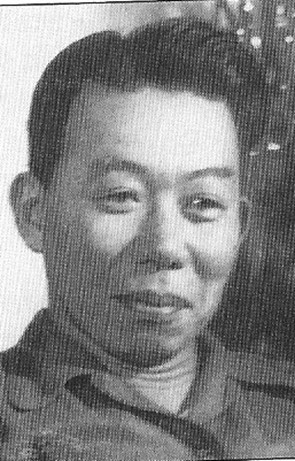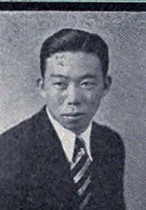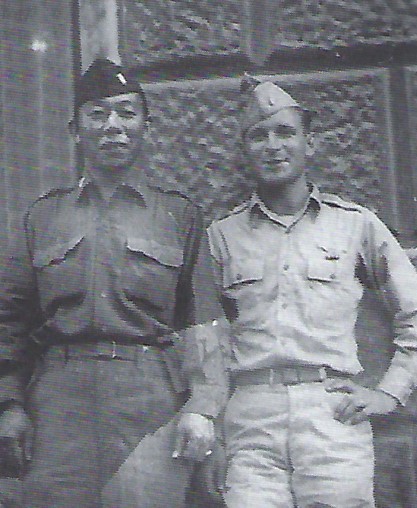
Yaso Abe
1st Lieutenant
442nd Regimental Combat Team
3rd Battalion, I Company
Yaso Abe was born on June 21, 1909, in Holualoa, Hawaii island, Territory of Hawaii. He was the son of Otokichi and Tatsu (Higuchi) Abe, who emigrated from Japan. Otokichi arrived in 1899 from the village of Tatara, Kasuya District, Fukuoka Prefecture. Tatsu arrived on January 8, 1908, on the S.S. Asia from the same village. There were five children in the Abe family: sons Yaso and Chitose, Yukio, and Minoru, and daughter Kikumi.

Otokichi and Tatsu worked on coffee farms in the Kona area. Yaso graduated from Konawaena High School and moved to Oahu in the late 1920s to attend the University of Hawaii (UH).
1933 UH senior class photo
While there, he was on the football team, and in the Agriculture Club, Uniwai Chapter of the Future Farmers of America (FFA), Military Order of Warriors of the Pacific, UH Rifle Team Honor Group, and the Reserve Officers Training Corps (ROTC). While at UH, he worked at the Seaside Hotel in Waikiki.
He graduated in 1933 with a degree in Vocational Agriculture and accepted a commission as a 2nd Lieutenant in the U.S. Army Reserves. He served with the Honolulu Police Department for a short time before accepting a teaching position in vocational agriculture at Aiea Elementary and Intermediate School.

In 1938, he married Emiko Suyama, daughter of Etsuji and Sumi Suyama of Hilo. She graduated from the University of Hawaii in 1934 with a Bachelor’s degree in Education and was a school teacher in Pahoa on Hawaii island.
Emiko Suyama in 1934
Yaso signed his draft registration card on October 26, 1940, Local Board No. 9, Waipahu Fire Station. His address was Halawa Ridge Road in Aiea, his point of contact was his wife, Emiko, who was residing in Pahoa, and he was employed by the Department of Public Instruction in Honolulu. He was 5’9½” tall and weighed 195 pounds. At this time, he was teaching at Aiea School, and was a member of the Leeward Lions Club, Aiea Civic Club, UH Extension Poultry Club, Ewa YMCA, and the Hawaii FFA.
When Pearl Harbor was attacked on December 7, 1941, Yaso and Emiko were at home in Aiea and saw the bombs landing only about a mile away.
Abe entered the U.S. Army as a 2nd Lieutenant on April 1, 1943. He was at Schofield Barracks prior to leaving on the S.S. Lurline with the other new soldiers on April 4 for California. From San Francisco the soldiers traveled by train to Camp Shelby, Mississippi, where they were assigned to different units of the newly formed 442nd Regimental Combat Team (RCT). Abe was assigned to 3rd Battalion, I Company. While he was there, Emiko lived in nearby Hattiesburg for a short period.
After over a year of basic and specialized training and military maneuvers, the 442nd left Camp Shelby for Camp Patrick Henry, Virginia, on April 22, 1944. They sailed in a convoy of over 100 ships from nearby Hampton Roads on May 2 – and arrived at Naples, Italy, on May 28. While her husband was overseas, Emiko lived at 2457 North 49th Street, Milwaukee, Wisconsin.
The 442nd spent time in a bivouac area in Bagnoli, near Naples, before transferring to a larger bivouac near Civitavecchia, just north of Rome. On June 26, near Suvereto they first entered combat, and 2nd and 3rd Battalions were the first to engage the enemy in a fierce firefight.
The 442nd moved north from Suvereto, liberating the towns of Belvedere, Sassetta, and Castagnetto. On July 1, they marched from Bibbona to an assembly area just south of the Cecina River. At that time of year, the river was hardly more than a trickle of water and very fordable in most places. Enemy artillery became increasingly heavy, indicating the enemy would make some sort of a stand on the high ground north of the river. By July 3, the 442nd’s infantry battalions had crossed the Cecina River and were advancing. The enemy held two key observation posts – Hill 140 and the town of Rosignano Marittimo. From these points the Germans directed a rain of shells at the forward battalions all day. Lt. Abe’s 3rd Battalion relieved the 100th Battalion at midday and this daylight maneuver brought on a storm of enemy self-propelled and artillery fire, causing heavy casualties.
Over the next few days the battle at Hill 140 was so intense that it was nicknamed “Little Cassino” after the famous battle at Monte Cassino earlier in the year (in which the 100th Battalion had fought while the 442nd was still in the US). After heavy fighting, Hill 140 was taken and the Combat Team pushed onward. Lt. Abe was wounded at Hill 140. Finally, after over three weeks on the front line, the 442nd was moved to a rest area around Vada. The men spent their time there bathing, cleaning their weapons, relaxing, and catching up on sleep.
While in Italy, Abe was promoted from 2nd Lieutenant to 1st Lieutenant.
On August 20, Lt. Abe’s 3rd Battalion was moved into the line along with the 2nd Battalion, relieving the 1st British Division on a six-mile front on the Greve River at its intersection with the Arno River. All along the front the 442nd was directed to make a considerable show of strength, patrolling aggressively to keep the enemy off balance and worried where the next strike would come from.
In early September the decision was made in the higher echelons of command to send the 442nd to France for combat in the Rhineland-Vosges Campaign. As a result, the unit moved to the port of Piombino on September 10 and embarked on Liberty ships for Naples. After arriving the next day, they settled into bivouac in a group of olive groves outside the city. On September 27 they left on troop transport ships for the port of Marseilles, France.
The Vosges Campaign saw the most intense battles the 442nd had experienced. Weather conditions and the terrain were miserable, the men were still in their summer uniforms, and the fighting was especially fierce.

After the fighting in the Vosges, which resulted in very high casualties, the depleted ranks of the 442nd were sent to the south of France to fight in the Rhineland-Maritime Alps Campaign, which was mostly a defensive position guarding the border with Italy. While there, off-duty men were able frequently to enjoy the hotels, restaurants, and bars of Nice.
Lt. Yaso Abe and Lt. Roy Gerkovich in Nice, 1945
From southern France, they were sent in mid-March 1945, back to Italy for combat in the Po Valley Campaign. The Combat Team’s presence in Italy was a closely kept secret as their mission was to conduct a diversionary attack on the western anchor of the Germans’ Gothic Line, an elaborate system of fortifications hewn out of solid rock and reinforced with concrete. The objective was to draw off German reserve units from the center of the Gothic Line where the main Allied attack was to be launched.
The 442nd entered battle on April 3, and engaged in hard-fought and hard-won successes as they pushed the enemy farther north. On May 2, 1945, the German forces in Italy surrendered. The 442nd went into bivouac at Nove Liguri, followed by occupation duties at Ghedi Airport and Livorno.
For his military service in World War II, Lt. Yaso Abe was awarded the Bronze Star Medal, Purple Heart Medal, American Campaign Medal, European-African-Middle Eastern Campaign Medal with four bronze stars, World War II Victory Medal, Army of Occupation Medal, Distinguished Unit Badge with one oak leaf cluster, and Combat Infantryman Badge. He was awarded the Congressional Gold Medal on October 5, 2010, along with the other veterans of the 100th/442nd Regimental Combat Team. This is the highest Congressional Civilian Medal.
After the war, Abe went to Wisconsin where Emiko was living with their first child, who had been born at the end of 1944. Using the GI Bill, he entered Stout Institute, a training school for “manual training” teachers, in Menomonie, Wisconsin. Yaso did graduate work there in the guidance field – and graduated with a Master’s degree on June 5, 1947. The family returned to Hawaii on the S.S. Matsonia on August 13. The following year the Army’s Organized Reserve Corps was established and thirty units were activated at a ceremony at Fort DeRussy in Honolulu. Among the units activated was the 442nd. Abe was promoted to Captain and put in command of L Company.
Yaso Abe returned to his teaching position at Aiea School and became Vice Principal. In 1962 he became the Principal of Kunia Elementary and Intermediate School and the family moved to the rural area of Kunia, surrounded by pineapple fields. He was active in many local affairs: Leeward Hospital, Aiea Athletic Association, Orchid Club, Lions Club, fundraising to build Aiea Methodist Church, neighborhood association, State Commission on Aging, Disabled American Veterans (DAV), and the Policy Advisory Board on Elderly Affairs. In 1961, he was promoted to Lieutenant Colonel in the U.S. Army Reserves.
After retiring from teaching after thirty years, Yaso and Emiko moved to Wahiawa where he became a member of the Wahiawa Hospital Association. In 1993, Abe was the Grand Marshall of the Wahiawa Veterans Day Parade. He was a regular attendee at 442nd Annual Banquets, where his daughter furnished her hand-made lei for all the veterans.
His daughter remembered his many wonderful traits:
A quiet man who liked to putter around in his backyard and greenhouse, he was always generous to everyone he met; and if he knew you wanted something he had, he would give it to you freely. He was always concerned about your welfare. A humble man, he was always interested in the other person and willing to engage you in conversation. He was a lifelong learner and an avid fan of UH Rainbow sports and Japanese TV programs. He was always willing to share his knowledge with whomever was interested in seeking his counsel, and he usually gave advice with great gentleness. Thank you for teaching us all by your fine example.
Yaso Abe died on October 1, 1998, in Wahiawa, and was inurned at the National Memorial Cemetery of the Pacific at Punchbowl, in Court 40, Row 300, Site 317. Survivors included his wife, their daughter and son, and all of his siblings. His wife, Emiko, died in 2005 and was inurned with her husband.
Researched and written by the Sons & Daughters of the 442nd Regimental Combat Team in 2022, at the request of Yaso Abe’s daughter, who is a long-time member.
